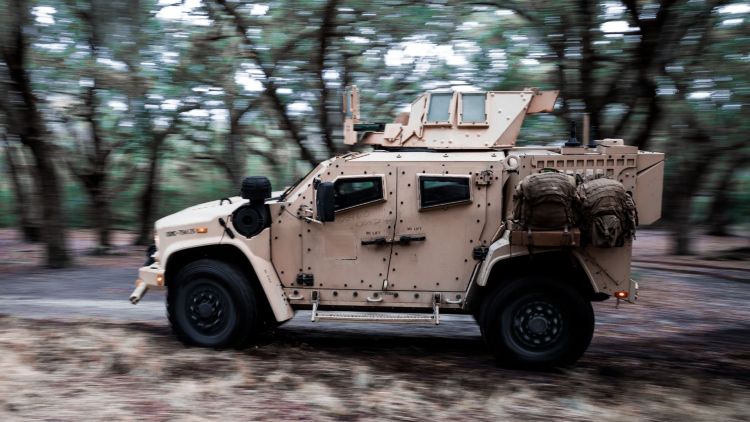Israel is doubling down on its defense modernization efforts, and the latest announcement is a big one.
Earlier this week, the Israeli Ministry of Defense unveiled plans to procure five new Reshef-class corvettes and hundreds of Joint Light Tactical Vehicles (JLTVs) for its defense forces.
This multi-billion shekel deal is part of a broader strategy to ensure the Israel Defense Forces (IDF) stay ahead in an increasingly volatile region.
Let’s take a closer look at what this means for Israel’s military, the tech behind these new acquisitions, and why they’re a big deal.
Reshef-Class Corvettes: A New Era for the Israeli Navy
The Reshef-class corvettes are set to replace the aging Sa’ar 4.5-class missile boats, which have been serving Israel since the 1980s.
Built by Israel Shipyards, these new vessels are the next step in the Navy’s evolution, building on decades of experience with missile-equipped fast-attack craft.
They’ll join Israel’s expanding fleet, which already includes the Sa’ar 6 corvettes that first saw action in the recent conflict with Hamas in Gaza.
So, what’s special about the Reshef-class? Reportedly, these ships are designed with advanced defense and combat systems, including the C-Dome air defense system, a naval version of Israel’s famous Iron Dome. They’re equipped for versatility, capable of handling missile threats, and providing robust maritime security.
Israel is doubling down on its defense modernization efforts, and the latest announcement is a big one.
Earlier this week, the Israeli Ministry of Defense unveiled plans to procure five new Reshef-class corvettes and hundreds of Joint Light Tactical Vehicles (JLTVs) for its defense forces.
This multi-billion shekel deal is part of a broader strategy to ensure the Israel Defense Forces (IDF) stay ahead in an increasingly volatile region.
Let’s take a closer look at what this means for Israel’s military, the tech behind these new acquisitions, and why they’re a big deal.
Reshef-Class Corvettes: A New Era for the Israeli Navy
The Reshef-class corvettes are set to replace the aging Sa’ar 4.5-class missile boats, which have been serving Israel since the 1980s.
Built by Israel Shipyards, these new vessels are the next step in the Navy’s evolution, building on decades of experience with missile-equipped fast-attack craft.
They’ll join Israel’s expanding fleet, which already includes the Sa’ar 6 corvettes that first saw action in the recent conflict with Hamas in Gaza.
So, what’s special about the Reshef-class? Reportedly, these ships are designed with advanced defense and combat systems, including the C-Dome air defense system, a naval version of Israel’s famous Iron Dome. They’re equipped for versatility, capable of handling missile threats, and providing robust maritime security.
The corvettes also feature a main gun at the bow, a modernized design compared to their predecessors.
While Israel hasn’t disclosed the exact cost, Sa’ar 6 ships—similar in size and capability—cost upwards of $400 million each, so it’s clear the Reshef-class is a significant investment.
These ships will replace eight Sa’ar 4.5 boats, ensuring Israel’s Navy remains a formidable force in the Mediterranean and beyond.
The JLTVs: Ground Forces Get a Major Boost
On the ground, the IDF is gearing up with hundreds of new JLTVs, locally designated as “Para.” These armored vehicles, manufactured by Oshkosh Defense, are a game-changer for Israel’s ground forces.
Designed to replace aging Humvees and M113 armored personnel carriers, the JLTVs bring modern features that are better suited to today’s battlefields.
The JLTV’s specs are impressive. Each vehicle is powered by a 6.6-liter diesel engine with a six-speed automatic transmission, giving it a range of up to 480 kilometers (298 miles) and a top speed of 110 km/h (68 mph).
Its V-shaped hull provides blast protection against improvised explosive devices (IEDs) and mines, while scalable armor enhances survivability in combat. These vehicles are highly versatile and can be outfitted with various weapons, including machine guns, grenade launchers, and anti-tank missiles.

The IDF plans to deploy JLTVs in key brigades like the Paratrooper and Kfir Brigades, enhancing their mobility and operational flexibility in urban and off-road environments.
Initial orders for 75 JLTVs were placed in 2023 through US Foreign Military Sales, with additional units acquired via direct commercial sales.
By 2024, the JLTVs were already in active service, proving their value on the ground.
Why These Acquisitions Matter
The timing of these upgrades isn’t random. The October 7, 2023 Hamas attack underscored the urgent need to fast-track defense modernization.
This deal, approved by the Nagel Committee, reflects Israel’s commitment to bolstering its military capabilities for the challenges of the next decade.
The Reshef-class corvettes provide advanced tools for the Israeli Navy to secure maritime routes, counter threats, and maintain regional dominance. They’ll be critical in protecting Israel’s economic interests, including offshore gas platforms, and ensuring freedom of navigation in contested waters.
On land, the JLTVs offer a much-needed upgrade for Israel’s maneuvering forces.
With better protection, mobility, and firepower, these vehicles will enhance the IDF’s ability to operate in diverse environments, from urban combat zones to rugged terrain. Their versatility and modern design ensure they’re ready for the unpredictable nature of modern warfare.
A Broader Strategy for the Future
These acquisitions are just one part of Israel’s broader defense strategy.
The Reshef-class corvettes join a Navy that has seen significant upgrades in the past decade, including the addition of Sa’ar 6 corvettes, new submarines, and advanced landing craft.
Meanwhile, the JLTV program aligns Israel with international trends, as other nations like Belgium, Lithuania, and Romania also integrate these vehicles into their forces.
Both programs highlight Israel’s approach to balancing domestic production capabilities with international partnerships.
For example, the JLTVs incorporate armored components from Plasan North America, an Israeli company. This integration supports local industries while leveraging cutting-edge foreign technology.
What’s Next?
While the deals have been approved by Israel’s defense ministry, they still need to go through the Knesset’s Joint Committee for the Defense Budget.
Once finalized, these acquisitions will take Israel’s military readiness to the next level, ensuring it remains prepared to counter emerging threats.
The Reshef-class corvettes and JLTVs represent more than just new equipment—they symbolize Israel’s commitment to staying ahead in a rapidly changing security landscape. By investing in cutting-edge technology and modernizing its forces, Israel is ensuring that its military remains a dominant force on both land and sea.
As these projects move forward, it’s clear that Israel is not only focused on addressing immediate threats but also laying the groundwork for long-term security and operational excellence. With these tools in hand, the IDF is well-positioned to navigate the challenges of the future.



